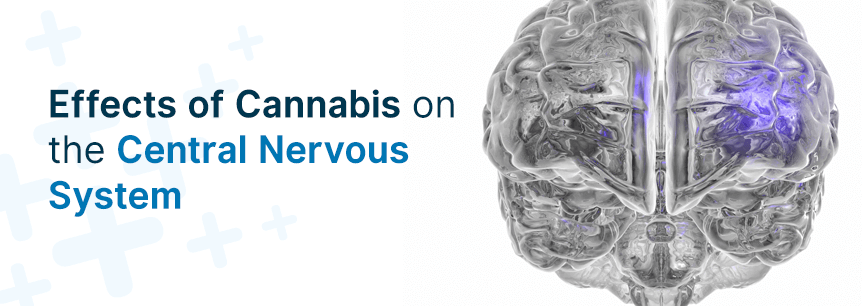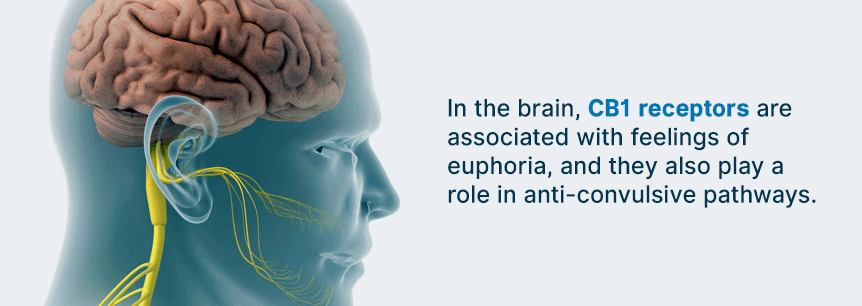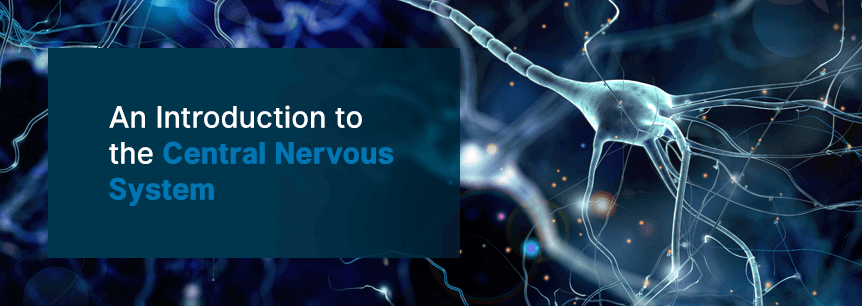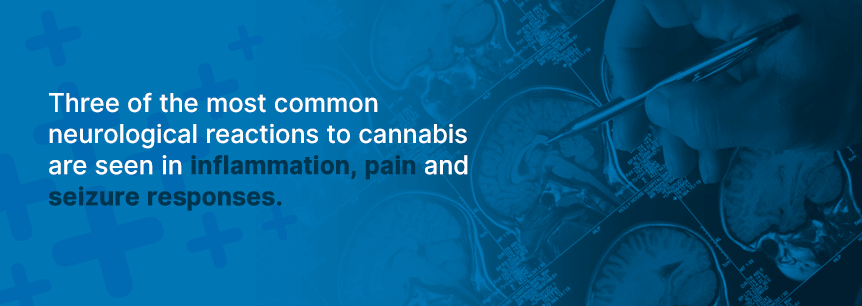
Marijuana directly interacts with the central nervous system. While many people assume this interaction is limited to a psychoactive “high,” cannabis does more than create a sense of euphoria and well-being.
Cannabis provides a wide range of neurological benefits, such as relieving pain, reducing inflammation and suppressing seizures. Understanding how marijuana works in your body will help you decide whether medical cannabis is a good treatment option for you or a loved one.
To grasp the ways marijuana affects the central nervous system, we must understand cannabinoids and their role in the body.
Cannabinoids are a group of chemical compounds that directly interact with the body. There are over 400 different natural compounds in the cannabis plant, and at least 85 of them are classified as cannabinoids. The two most-known cannabinoids are tetrahydrocannabinol (THC) and cannabidiol (CBD), and each one interacts with the body differently.

Medical marijuana manufacturers and growers can alter cannabis plants to highlight a particular cannabinoid. This allows growers to increase the effects of a specific cannabinoid, making certain strains highly specialized to target different body systems.
Cannabinoids interact directly with our bodies through the endocannabinoid system (ECS). The ECS is a complex system that assists the body in maintaining homeostasis — it helps regulate metabolism, intracellular communication, appetite and memory, along with our immune and pain responses.
The human body naturally produces its own cannabinoids, known as endocannabinoids. The ECS is designed to regulate and dispense these compounds throughout the body, so the cannabinoids from marijuana seamlessly integrate into the body’s own system. Until researchers began studying the effects of marijuana on the body, the ECS system was unknown — after studying cannabinoids and their cellular interactions, scientists discovered an entirely new bodily system.
The ECS has two types of receptors — CB1 and CB2. Each receptor binds to a specific part of the ECS and affects different systems, and individual cannabinoids activate different receptors.
CB1 receptors are scattered throughout your body, but they predominantly cluster in the brain and spinal cord. In the brain, CB1 receptors are found in the basal ganglia and the hippocampus. They are also found in the cerebellum and the reproductive organs.
These receptors are primarily found in locations associated with the particular behaviors they affect. For example, CB1 receptors are in the amygdala region of the brain, which helps process memories and emotions. They are also located in the hypothalamus, which regulates appetite. The presence of CB1 receptors in these areas explains how marijuana often impacts appetite and emotions in users.

In the brain, CB1 receptors are associated with feelings of euphoria, and they also play a role in anti-convulsive pathways.
The only places where CB1 receptors are absent in the brain are the medulla oblongata and the brain stem. The brain stem and medulla oblongata are responsible for cardiovascular and respiratory functions — because those areas don’t have cannabinoid receptors, they are unaffected by marijuana. The lack of cannabinoid receptors on the medulla also explains why there has never been a case of an overdose of THC, regardless of the amount consumed or the method of consumption. Likewise, a lack of cannabinoid receptors on the mesocorticolimbic pathway means that there is a significantly decreased chance of physical addiction because a dopaminergic pathway is not involved.
CB1 receptors are also located in nerve endings, where they help reduce pain sensations. The majority of CB1 receptors are found in your central nervous system, where they provide effects such as:
Of all the cannabinoids, THC engages with CB1 receptors the most. This explains the psychoactive effects of THC as opposed to other cannabinoids — when THC enters the body, it primarily impacts the neurological centers of the body.
CB2 receptors are located in the peripheral nervous system and the immune system. They are found in the tonsils, thymus gland and the spleen, and they function primarily as anti-inflammatory agents — once CB2 receptors are activated, they begin an immune response to reduce inflammation and tissue damage throughout the body.
The CB2 receptors are most active in immune suppression. While this may seem counterproductive, there are many autoimmune diseases where the body’s natural immunity begins to attack healthy cells. The anti-inflammatory component of cannabis has been influential in developing treatments for demyelinating disorders such as multiple sclerosis and Parkinson’s disease.
CBD is the cannabinoid most likely to interact with CB2 receptors. Marijuana strains high in CBD don’t activate the endocannabinoid system receptors in the central nervous system like THC — instead, CBD works in organs and systems related to immune and inflammatory responses.

The central nervous system (CNS) consists of the spinal cord and the brain. It’s called the “central” nervous system because it acts as a central information point for the entire body — the CNS combines signals received from all bodily systems and coordinates activity across the whole organism.
The CNS controls our thoughts, emotions, movements and desires — it regulates everything, from our respiration and heart rate to the release of hormones.
The most complex organ in the body, the brain is responsible for controlling and coordinating activity throughout the rest of the systems.
Researchers estimate over 100 billion neurons and 1,000 billion glial cells make up the brain. These cells are responsible for a vast range of functions, ranging from creating memories to making sense of our environment. The brain is highly specialized, and each section of the organ has a particular role. However, many higher functions like creative tasks or solving problems require different areas to coordinate and work together.
The brain is roughly divided into four lobes:
Each of these lobes has smaller, even more focused areas responsible for specific tasks, such as the cerebellum and the hypothalamus.
The spinal cord runs down our backs, and it carries signals between the rest of our body and the brain.
One of the spinal cord’s major functions is coordinating motor activity. Motor commands from the brain race down the spinal cord to the muscles, and sensory information travels through the spinal cord to the brain.
The spinal cord also controls various reflexive responses to our environment. For example, if you touch something hot and jerk your arm away involuntarily, that reflex was sent from the spinal cord. Your brain hadn’t had time to realize the surface was hot and orchestrate an intentional action — your sensory tissues sent information straight to your spinal cord, which prompted you to act before the brain processed what was happening.
The circuits in the spinal cord also coordinate complex movements like walking. The spinal cord can control all of the muscles necessary for walking, even without the input of the brain — in one study, a cat whose brain had been separated from its spinal cord still instantly walked when it was placed on a treadmill. The spinal cord allows you to walk without receiving signals from the brain — however, the brain is required to begin, stop or change movements, such as avoiding an obstacle or turning.
Through the endocannabinoid system, marijuana directly impacts the central nervous system. On the cellular level, this impact is seen in the inhibition of adenylate cyclase, the suppression of calcium and sodium channels and the activation of mitogen-activated protein (MAP) kinase enzymes in the body.
When THC binds to CB1 receptors, it inhibits the enzyme adenylate cyclase, which is responsible for converting the chemical adenosine triphosphate (ATP) to cyclic adenosine monophosphate (cAMP). Cyclic AMP is the secondary messenger for protein kinase A — by inhibiting adenylate cyclase, THC passively shuts down the A-type potassium channel.
The A-type potassium channel is responsible for numerous functions, including the regulation of neurotransmitter release, epithelial electrolyte transport, smooth muscle contraction, insulin secretion, heart rate, neuronal excitability and cell volume.
Another way THC replicates the anandamide receptor system in the central nervous system is that it directly inhibits N and P/Q-type, voltage-dependent calcium and sodium channels. These channels are responsible for the release of neurotransmitters at the presynaptic cleft.
Inhibiting these channels prevents the influx of sodium and calcium, therefore inhibiting the release of neurotransmitters, L- glutamate, GABA, noradrenaline, 5-HT and acetylcholine.
Lastly, one of the major mechanisms of action of THC in the brain is to activate the MAP kinase enzyme. This pathway is known to contribute to regular cellular activities, including gene expression, cell proliferation, differentiation and ultimately the apoptotic pathway. This pathway could be instrumental in discovering the anti-tumor properties of the cannabinoids.
All of these various neurological effects influence many responses in the body. However, three of the most common neurological reactions to cannabis are seen in inflammation, pain and seizure responses.

Through its interactions with the central nervous system, cannabis has been shown to reduce inflammatory responses in the body.
Inflammation is part of the body’s immune response. Through CB2 endocannabinoid receptors, marijuana can interact with the immune system to reduce inflammation in patients with a wide range of conditions.
A growing body of evidence shows cannabinoids are strong anti-inflammatory agents in the body. In several mice studies, THC has repeatedly suppressed inflammatory responses. Additionally, current research suggests cannabis could be helpful in treating neurodegenerative disorders that combine inflammation, such as multiple sclerosis, Alzheimer’s disease and Parkinson’s disease.
The pain-relieving benefits of cannabis have been well-documented in users around the world and across time. Marijuana is especially effective at alleviating neuropathic pain — due to its interaction with the spinal cord, cannabis helps intercept and reduce pain signals going to the brain.
For people experiencing chronic or temporary pain, marijuana has proven to be a deeply relieving treatment option and a safer alternative to opioid medications. Cannabis is especially effective for pain relating to the central nervous system — in one study, cannabinoids helped reduce inflammatory and neuropathic pain in patients suffering a wide range of illnesses and disorders.
In another scientific study, THC was shown to reduce pain intensity for people with nerve injuries resulting in central neuropathic pain. Considering that THC activates ECS receptors throughout the central nervous system, this result makes sense — the pain-relieving benefits of marijuana have made it an appealing alternative for many suffering from nerve pain.
One of the most widely publicized benefits of marijuana is its effect on seizures.
For people with epilepsy or other seizure disorders, marijuana use has helped reduce the frequency and intensity of their seizures. A study conducted in 2017 provides evidence that CBD improved seizure control in patients with epilepsy, and in a 2016 study, researchers determined that THC helped reduce the pain, spasms and spasticity of seizures in patients with multiple sclerosis.
In 2018, the United States Food and Drug Administration (FDA) approved a CBD-based oral medication for the treatment of seizures in two forms of epilepsy. This medication, Epidiolex, is the first drug to be approved by the FDA that contains CBD. The approval of Epidiolex cements marijuana’s beneficial effect on seizures, and it marks a significant change in the national perspective regarding marijuana as medicine.
Studies have proven that marijuana impacts the central nervous system. However, while many people may assume these effects are negative, this is not an accurate understanding of the role of cannabinoids and the endocannabinoid system on the body.
Current research shows how marijuana can be an effective treatment option for issues relating to the central nervous system — because cannabis directly interacts with our nerve responses, it can help reduce inflammation, relieve pain and suppress seizures in the body.
If you are looking for a natural, holistic and effective treatment for you or a loved one, consider medical marijuana. Medical cannabis has successfully treated a wide range of disorders, and much of its effectiveness stems from its engagement of the central nervous system.
Check out our resources and conditions pages to learn more about medical marijuana and its potential side effects. Let us help improve our quality of life — browse our directories to find a dispensary or certified marijuana doctor near you today.


Please allow us to access your location to find local dispensaries.
VIEW ALL DISPENSARIES ➔